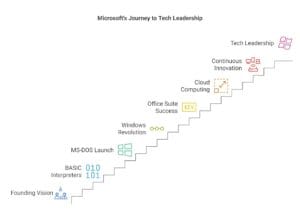Microsoft, a name synonymous with technology, boasts a remarkable history that began not with grand ambitions, but with a shared passion for computing. In 1975, two young visionaries, Bill Gates and Paul Allen, embarked on a journey that would revolutionize the world.

Their initial venture, Micro-Soft (later shortened to Microsoft), focused on developing BASIC interpreters for the Altair 8800, a groundbreaking personal computer. This early success laid the foundation for Microsoft’s foray into operating systems, culminating in the development of MS-DOS, an operating system that would become the industry standard.
The release of MS-DOS in 1981 marked a pivotal moment in Microsoft’s trajectory. It provided a stable and user-friendly platform for personal computers, paving the way for the proliferation of PCs in homes and offices worldwide. This success further fueled Microsoft’s growth and enabled them to expand into other software domains.
One of Microsoft’s most significant achievements is the development of Windows, a graphical user interface (GUI) that revolutionized how people interact with computers. The first version of Windows, released in 1985, introduced the concept of a visual desktop with icons and windows, making computing more intuitive and accessible to a wider audience.
The subsequent versions of Windows, including Windows 95, Windows XP, and Windows 10, continued to refine and enhance the user experience, solidifying Windows’ position as the dominant operating system in the global market.
Beyond operating systems, Microsoft has diversified into a wide range of software products and services. Microsoft Office, a suite of productivity applications including Word, Excel, and PowerPoint, has become an indispensable tool for businesses and individuals worldwide.
Cloud computing has emerged as another key area of focus for Microsoft, with Azure, their cloud computing platform, offering a comprehensive suite of services for businesses of all sizes.
Microsoft’s commitment to innovation has driven its continuous growth and evolution. The company has consistently invested in research and development, fostering a culture of innovation that has led to groundbreaking technologies in areas such as artificial intelligence, gaming, and search.
Microsoft’s journey from a small startup to a global technology behemoth is a testament to the power of vision, innovation, and perseverance. The company’s founders, Bill Gates and Paul Allen, nurtured a culture of excellence and embraced challenges, propelling Microsoft to the forefront of the technology industry.
Today, Microsoft continues to shape the future of technology, pushing the boundaries of innovation and empowering individuals and organizations around the world.
Key takeaways from Microsoft’s startup journey:
- Vision and Passion: The founders’ shared passion for computing fueled their early endeavors and guided their long-term vision.
- Focus on Customer Needs: By addressing the needs of early adopters, Microsoft established a strong foundation for future growth.
- Continuous Innovation: Microsoft’s commitment to research and development has driven its ability to adapt to changing market demands.
- Building a Strong Team: Cultivating a talented and dedicated workforce has been crucial to Microsoft’s success.
- Embracing New Technologies: Microsoft has consistently embraced emerging technologies, such as cloud computing and artificial intelligence, to maintain its competitive edge.
Microsoft’s story serves as an inspiration for aspiring entrepreneurs and a reminder that with dedication, innovation, and a customer-centric approach, even the most ambitious goals can be achieved.
Subscribe:
Stay connected with the latest updates, exclusive insights, and curated content by subscribing to my newsletter.
